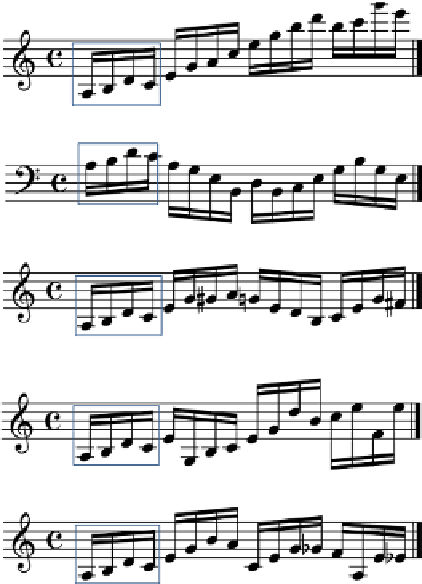Information Technology Reference
In-Depth Information
Fig. 5.24
The starting 4-note
phrase is in the box. Here, a
continuation with 'higher
pitch' (
mean pitch
=
78.5
>
59.5)
Fig. 5.25
A'lowerpitch'
continuation (
mean pitch
=
52.41
<
59.5) (here in the
bass clef)
Fig. 5.26
A'more
chromatic' continuation
(
mean interval
=
0.666
<
2.33)
Fig. 5.27
A 'less chromatic'
continuation (
mean interval
=
2.33). Note the large
intervals
Fig. 5.28
A 'less tonal'
continuation (
tonalness
=
0.66
<
1.0). Note the Gb and
Eb
higher/lower pitch
,
more/less chromatic
, and
less tonal
. Figures
5.24
-
5.28
show
continuations which optimise these five criteria, as confirmed by the values of the
features. These values are compared to the initial 4-note phrase values, i.e.:
•
Mean pitch: 59.5;
•
Mean interval: 2.33;
•
Tonalness (in the key of
A minor
): 1.0 (all notes in
A
minor).
It is important to note that this control mechanism is independent from the
other mechanisms introduced here, notably formal transforms (see Fig.
5.23
). Fig-
ures
5.29
and
5.30
show a combined use of transforms and controls on the chord
sequence of Fig.
5.7
. It can be checked that indeed the generated phrase do satisfy
all the criteria.
5.5.3 Reusing Intentional Scores
The intentional score is the collection of all decisions taken for each beat. As we
have seen above, these decisions concern (1) the choice of the rhythm pattern, (2) the
choice of the scale (and hence, of the Markov database), (3) the decision to use and
the selection of a formal transform, (4) the decision to control the generation with a
specific criteria, and (5) the decision to start or stop the phrase. This score is a time

